
Roscrea is a market town in County Tipperary, Ireland, which in 2016 had a population of 5,446. Roscrea is one of the oldest towns in Ireland, having developed around the 7th century monastery of Saint Crónán of Roscrea, parts of which remain preserved today.

Cloughjordan, officially Cloghjordan, is a town in County Tipperary in Ireland. It is in the barony of Ormond Lower, and it is also a parish in the Roman Catholic Diocese of Killaloe.
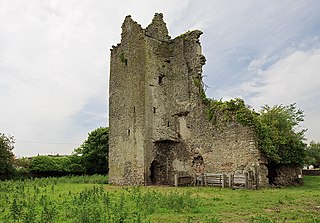
Borrisoleigh is a small town in County Tipperary, Ireland. At the 2016 census, it had a population of 679. It is in the ecclesiastical parish of Borrisoleigh and Ileigh in the Roman Catholic Archdiocese of Cashel and Emly.

Moneygall is a small village on the border of counties Offaly and Tipperary, in Ireland. It is situated on the R445 road between Dublin and Limerick. There were 313 people living in the village as of the 2016 census. Moneygall has a Catholic church, motorway service station, a car sales and repair centre, a national school, a Garda station and two pubs. The nearest Church of Ireland church, Borrisnafarney, is 2 km from the village beside the former Loughton Demesne.

Ballyhack is a small village located in the south-west of County Wexford, in Ireland, on the eastern shore of the Waterford Harbour, which is the estuary of The Three Sisters
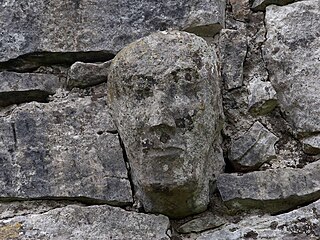
Temple Cronan is a ruined medieval oratory or chapel built near a holy well in the Burren, County Clare, Ireland. The current building apparently dates from the 12th and 15th centuries, although it may partly incorporate earlier buildings or some of the masonry thereof. It may have been the site of an early Christian monastery. Temple Cronan is located in the civil parish of Carran, eight miles from Corofin and about sixteen miles from Ennis.

Dunkerrin is a small village in County Offaly, Ireland, just south of Roscrea and near the County Tipperary border. It is on the R445 road which was once the main road from Dublin to Limerick. Dunkerrin is now bypassed by the M7, the nearest access is junction 23 at Moneygall.
John Bowden was an Irish architect and member of the Board of First Fruits of the Church of Ireland from 1813 to 1821. He was born in Dublin and died in 1822.
Modreeny is a townland and a civil parish in the historical barony of Ormond Lower, County Tipperary in Ireland situated on the R490 road between the towns of Borrisokane and Cloughjordan. Ormond Foxhounds are based at kennels at Modreeny.
The Board of First Fruits was an institution of the Church of Ireland that was established in 1711 by Anne, Queen of Great Britain to build and improve churches and glebe houses in Ireland. This was funded from taxes collected on clerical incomes which were in turn funded by tithes. The board was replaced in 1833 by the Board of Ecclesiastical Commissioners.
John Benjamin Keane was an Irish architect of the 19th century. (d.1859). He was engineer on the River Suir navigation.

St Nidan's Church, Llanidan is a 19th-century parish church near the village of Brynsiencyn, in Anglesey, north Wales. Built between 1839 and 1843, it replaced the Old Church of St Nidan, Llanidan, which needed significant repair, providing a place of Anglican worship nearer to the village than the old church. Some items were moved here from the old church, including the 13th-century font, two bells from the 14th and 15th century, and a reliquary thought to hold the remains of St Nidan. The tower at the west end has been described as "top heavy" and looking like "a water tower".
Sean Ross Abbey south of Roscrea in County Tipperary, Ireland, is a convent and the location of St Anne's Special School run by the Sisters of the Sacred Hearts of Jesus and Mary. St Crónán is believed to have founded a monastery at this location in the 6th century.

St Piran's Church is an active Anglican parish church in Perranarworthal, Cornwall, England. It is part of a united benefice consisting of eight churches, the Eight Saints Cluster, in the parishes of Stithians with Perran-Ar-Worthal and Gwennap. The benefice has four licensed clergy and four readers. The church, dedicated to Saint Piran, is in the Carnmarth, North deanery, the archdeaconry of Cornwall and the Diocese of Truro. The church was granted Grade II* listed status in May 1967. The churchyard contains several listed chest tombs and headstones.

Roscrea Castle is a 13th-century motte castle in the town of Roscrea, Ireland. The Castle consists of a walled courtyard, gate block, and angled towers. Along with 18th century Damer House and gardens, the Castle forms part of Roscrea Heritage Centre.
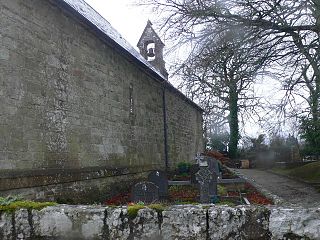
St. Cronan's Church is a 10th-century Church of Ireland church in Tuamgraney, County Clare, Ireland. It is the oldest church in continuous use in Ireland. The Tuamgraney parish operates as a unit with the Mountshannon parish in the Killaloe Union of parishes in the Diocese of Tuam, Limerick and Killaloe.
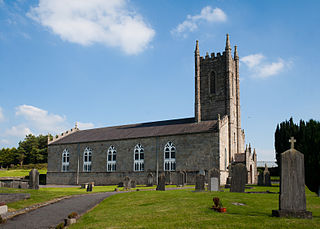
James Sheane was an architect from Roscrea, County Tipperary, Ireland.
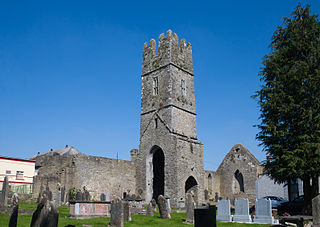
Roscrea Friary is a ruined medieval Franciscan friary and National Monument located in Roscrea, County Tipperary, Ireland. It is on Abbey Street, in the west end of Roscrea, on the north bank of the River Bunnow. The Friary was founded in the 15th century by Greyfriars (Franciscans) and later destroyed by British soldiers. What remains are the north and east walls and the bell-tower.
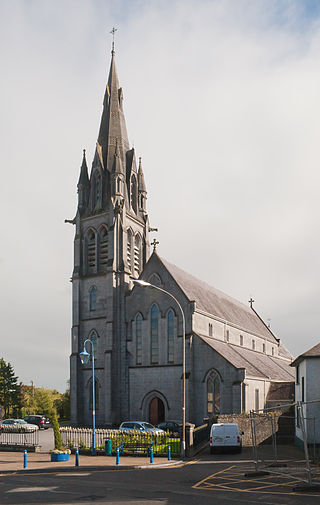
St. Michael's Church is a large-scale Roman Catholic church built of limestone located on the south end of Saint Michael's Square, Ballinasloe, County Galway, Ireland. It was designed by J.J. McCarthy in 1846 and was built in 1858.

















